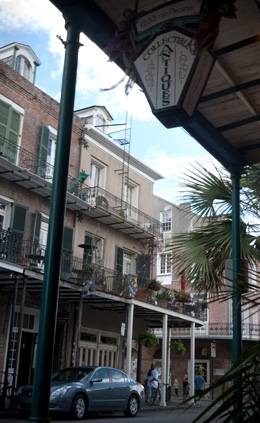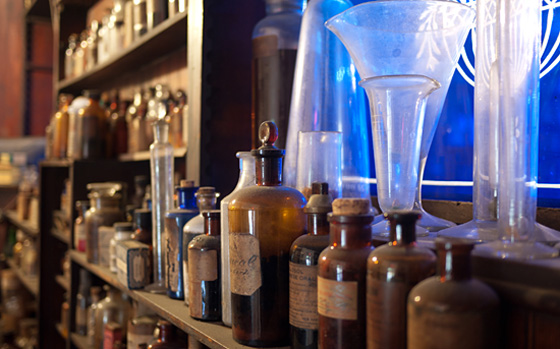The Dixie Drug Store
New Orleans is a blur. It started with a pint over lunch just after we arrived and then there were a few more pints at the coffeeshop down the street from our hotel, where an obnoxious group of people scouting locations for a movie eventually drove us on, to the statue of Ignatius Reilly, then a casino, a slightly lighter wallet, the best muffaletta I’ve ever had, some very old graves, an unlikely amount of pork, a transvestite beauty pageant and then we hit the road again.
 Which is not to say I was drunk the whole time, just that somewhere between the beer and the stifling humidity and wholly unique character of New Orleans, everything becomes less distinct.
Which is not to say I was drunk the whole time, just that somewhere between the beer and the stifling humidity and wholly unique character of New Orleans, everything becomes less distinct.
New Orleans is only technically part of the United States, a act of map making more than anything else. For me, New Orleans has always been the one foreign country I can visit without a passport.
New Orleans is it’s own world. So much so that’s it’s impossible to put your finger on what it is that makes it different. New Orleans is a place where the line between consensus reality and private dream seems to have never fully developed. And a wonderful world it is.
The New Orleans Pharmacy museum sticks out amidst the blurry series of events, perhaps because it was air conditioned, perhaps because of the Grant Lee Buffalo song from which the title of this entry is taken, or perhaps because pharmacology is simply fascinating no matter where you are, New Orleans just happens to have the perfect shrine to it.
Whatever the case, the museum is a brilliant glimpse of the halcyon days of early chemical experimenters — that early world where chemicals were understood well enough to be occasionally useful and not well enough to be occasionally dangerous. A time of self-taught chemists, enthusiastic, evangelical drug fiends, pioneers and yes, outright quacks.
It seems everyone used to be mixing up some sort of medicine in the basement.

In New Orleans there’s also a strong connection between the old Vodun religious practices and the potions, cure-alls, medicines and straight quackery that used to be the local drugstore.
If, like me, you’ve ever wondered what happened to the days when Coke actually contained cocaine, every woman kept a laudanum tin by the bedside and anyone was generally free to put whatever they liked — for good or bad — in their body, then you are no doubt aware of the Harrison Narcotic Act of 1914.
The bill, which overnight made a series of plants and their by-products illegal, is one of those lines in the sand, a marker where, on one side, is total anarchistic freedom (that would be prior to the Harrison Act) and on the other side restrictions, regulations and a government that is suddenly in charge of what you can and cannot do with your body and mind.
 I don’t have any strong opinions on the Harrison Act — it is what it is, and it’s far too late to change it. But I do think that time before it sounds like more fun. Sure, there were some wacky chemicals for sale, things that would poison and kill you, but there are still hundreds of lawsuits every year against so-called medicines that have caused people harm.
I don’t have any strong opinions on the Harrison Act — it is what it is, and it’s far too late to change it. But I do think that time before it sounds like more fun. Sure, there were some wacky chemicals for sale, things that would poison and kill you, but there are still hundreds of lawsuits every year against so-called medicines that have caused people harm.
The difference is that now we have a huge multi-billion dollar pharmaceutical industry that gets to crank out the drugs that kill us. At the end of the day the pharmaceutical industry is about as interested in your health as the smiling shysters hawking jars of god-knows-what out the back of a gaudily painted wagon.
Walking the rooms of the New Orleans Pharmacy Museum with their seemingly endless shelves full of oils and sprays and pipes and potions proudly proclaiming to cure everything from hiccups to money, luck and love, was a beautiful trip back to time when people did things for themselves; when things were not simpler, they were more complicated and risky in fact, but you were in charge. It was your job to educate yourself, to make decisions, to experiment if you wished, abstain if you did not.
Stepping back out into the humid heat of Rue de Chartres was like being rudely sucked back to the present world. Fortunately New Orleans is there to cushion your abrupt arrival in the present, more strangeness is right around the corner, you just have to keep walking.
We walked up to the St. Louis Cemetery, not because it’s especially strange, but because I had not been there for sixteen years. So much has changed between then and now it boggled my mind and I mostly walked in silence thinking about the road trip I took sixteen years ago. We had no cellphones then, we wrote on paper with pens, we used paper maps to get around. We were nineteen. The world was utterly different.
Except for the graveyard. Not much changes in graveyards. The neighborhood around St. Louis Cemetery No. 1 has improved somewhat. There was a giant pyramid crypt that I don’t remember from the last trip, but otherwise the graveyard looked just as it did when I was nineteen years old.
I even managed to take the same picture:
 Angel on a crypt, St. Louis Cemetery No. 1, New Orleans 1995
Angel on a crypt, St. Louis Cemetery No. 1, New Orleans 1995
 Angel on a crypt, St. Louis Cemetery No. 1, New Orleans 2010
Angel on a crypt, St. Louis Cemetery No. 1, New Orleans 2010
The 2010 version needed to be carefully framed to avoid some new buildings to the south and a bit of Photoshop was necessary to get rid of a stoplight that didn’t use to be there, but I do find it remarkable, given how much the world around us has changed in fifteen years, that this scene is still there.
No one wants to live in a world that never changes, but sometimes it’s nice to know that bits of the world remain as they ever are.
Thoughts?
Please leave a reply:
All comments are moderated, so you won’t see it right away. And please remember Kurt Vonnegut's rule: “god damn it, you’ve got to be kind.” You can use Markdown or HTML to format your comments. The allowed tags are
<b>, <i>, <em>, <strong>, <a>. To create a new paragraph hit return twice.